Learn how to make easy homemade canned applesauce with a variety of apples. Choose the mix of sweet or tart apples and customize the recipe to suit your taste. One of the best things about making your own canned applesauce is that you can adjust the ingredients and make it just the way you like it. As a veteran apple grower, I know first-hand the different flavors that can be achieved by combining various apples. Like tart canned applesauce? I’ll give you ideas about the kinds of apples you might want to use. A fan of sweeter canned applesauce? Get inspired to try the types of apples I suggest. Whatever your flavor preferences, you can have fun testing and experimenting with your own special blend when you make your own homemade canned applesauce with this easy apple sauce recipe for canning.
Table of Contents
My Canned Applesauce Backstory
Even though we have grown apples for decades, I didn’t like applesauce until we had dinner at a friend’s house a number of years ago and were served applesauce as a condiment to go with some spicy German sausages. I gave it a try, and it was amazing! The sweet and tart applesauce complimented the spices in the sausages to create a whole new flavor experience. I was hooked! I’ve now made canned applesauce for years using our home-grown apples. Read on for the easy recipe.
This post contains affiliate links, which means I may earn a small commission from qualifying purchases at no additional cost to you. Please read my Policies page for more information.
Seeing New Possibilities
We happen to have a small apple orchard, but in the past, I have mainly used the apples for apple crisp or apple cider. Unfortunately, despite my best efforts, quite a few apples went to waste. This year, I was determined to do better. I gave apples away and I made as much apple crisp as we could eat. When I decided to replicate the applesauce and sausage combination at my own dinner table a short time ago, I put applesauce on my grocery list. Wait a minute! I had a whole orchard full of apples just waiting to be used. Since I had never eaten applesauce before, I hadn’t concocted homemade applesauce. I looked for a good recipe and gave it a try.
Testing and Tweaking
I found a recipe that looked easy, but I was lacking a couple of ingredients. I also wanted to make enough to preserve in my trusty pressure canner, so I needed to increase and adapt the recipe to be canner-friendly. The result is the easy homemade applesauce recipe below. The most time-consuming part of the process is peeling the apples. I make that more bearable by turning on a movie or listening to podcasts!

Which Kind of Apples are Best for Applesauce?
At my house, we are fortunate to have an orchard filled with heirloom apple trees. I like to experiment with different combinations. They are all delicious. The larger apples mean less peeling, so I usually use the larger varieties, like Hudson’s Golden Gem. Pink Pearl apples make a lovely pink applesauce.
Here is a mix of Pink Pearl apples with a few Summer Rambo mixed in. We have many varieties of heirloom apples in our orchard. I usually try to peel more than I will need for 5 pints, and if I have any extra applesauce, I just put it in a storage container and refrigerate the surplus.
Supplies
Of course, you do not have to can this applesauce. If you reduce the quantity, you may just want to store the syrup in the refrigerator. The full recipe makes about five pints, so here is the equipment you need to assemble beforehand if you are going to can the applesauce. You will need:
Five pint-sized canning jars, bands, and lids
A pressure canner like this one. With this, I can process up to 16 pints at one time.
A small metal saucepan with lid (for heating the jar lids)
A large stockpot (for cooking and blending the applesauce)
An immersion blender is optional, but very nice to have if you are a fan of smooth applesauce.
1 set of canning tools which have made all the difference for me. I dreaded canning before I made this purchase because I made such a mess all over the kitchen. The tools in the set, especially the funnel, have cut down on the canning mess immensely. I am also able to safely handle the hot jars using the tongs, lid lifter, jar wrench, and jar lifter. I would have given up canning long ago were it not for these tools. I’ve had my set for about 15 years.

 Preparation for Making Canned Applesauce
Preparation for Making Canned Applesauce
Set five canning bands (some call them rings) aside, near where you will be filling the jars.
Place the five glass jars in the water bath canner. The water should cover the jars by at least an inch. Turn the heat to medium-high.
Place five jar lids in the small saucepan with enough water to cover the lids. Cover the pan and heat the water on low. I’ve always been told not to let the water come to a boil. Now it’s time to make the applesauce!
Easy Homemade Canned Applesauce Ingredients
6 to 8 lbs of apples (about 14 to 20 apples, depending on the size), peeled, cored, and quartered (Some say Gravensteins are best. I used a variety of heirloom apples from our orchard. Any combination will work.)
6 Tbsp lemon juice (more or less to taste)
1 teaspoon ground cinnamon
Up to 1 cup of white sugar
2 cups of water
1 teaspoon of salt (Surprise! Salt really brings out the flavor of the fruit.)
Directions for Making Canned Applesauce
Peel and core the apples. I like to do this while watching a movie or listening to a podcast.
Here are some peeled Pink Pearl apples ready to be cored and sliced.
Place the peeled, cored, and quartered apples into a large pot. Add the lemon juice, cinnamon, sugar, water, and salt.
Bring to a boil on high heat, then lower the temperature, cover the pot, and maintain a low simmer for about 30 minutes, until the apples are completely tender and cooked through.
Once the apples are cooked through, remove the pot from the heat. Mash the cooked apples. You can use a potato masher to mash the cooked apples in the pot to make a chunky applesauce. I like to use a round masher, like this one.

Important: The apples need to be removed from the heat before mashing. If this is not done, the hot apple mixture will splatter all over. Trust me, I know this.
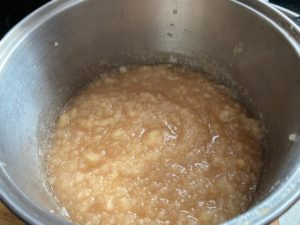
After mashing, if you would like a smoother applesauce, use an immersion blender. It’s great for pureeing soups as well!
This photo was taken after using the immersion blender for only one minute. What a difference it made!
If the applesauce is too thick, add more water to thin it out. Not sweet enough? Add more sugar to taste. If too sweet, add more lemon juice.
Pour applesauce into pint jars, leaving 1/2 inch of headspace, and process the jars in a pressure canner for 8 minutes at 6 pounds of pressure.
Makes about 5 pints.
Common Canned Applesauce Questions
How long is canned applesauce good for?
Canned applesauce, when properly stored, can have a relatively long shelf life. The exact duration of its quality and safety depends on several factors, including the packaging, storage conditions, and whether it’s been opened. Here are some general guidelines:
Unopened Canned Applesauce: If the can is unopened and stored in a cool, dry place, it can last for an extended period, often beyond the manufacturer’s “best by” or “use by” date. Commercially canned applesauce typically has a shelf life of 1 to 2 years or more. However, it’s essential to check the expiration date on the can and inspect the can for any signs of damage or bulging before use.
Opened Canned Applesauce: Once you open a can of applesauce, its shelf life decreases significantly. When refrigerated and kept in an airtight container, opened canned applesauce can last for about 1 to 2 weeks. It’s essential to refrigerate any unused portion promptly and ensure the container is sealed to prevent moisture and contaminants from affecting the applesauce.
Home-Canned Applesauce: If you’ve canned applesauce at home, the shelf life can vary depending on the quality of the canning process and storage conditions. Properly home-canned applesauce can last for up to 1 year or longer if stored in a cool, dark, and dry place.
To ensure the safety and quality of canned applesauce:
Store unopened cans in a cool, dry, and dark place, away from direct sunlight and temperature fluctuations.
Check the can for any signs of damage, rust, or bulging before using it. Damaged cans should be discarded.
Once opened, transfer the remaining applesauce to an airtight container and refrigerate promptly.
If you’re uncertain about the safety or quality of canned applesauce, particularly if it has been stored for an extended period, consider conducting a sensory evaluation. Look for any unusual odors, flavors, or changes in color or texture, and discard the product if any concerns arise.
Does applesauce need to be pressure canned?
Whether or not applesauce needs to be pressure canned depends on how you plan to store it and for how long.
Refrigeration: If you plan to consume the applesauce relatively quickly (within a week or two) and store it in the refrigerator, there’s no need for pressure canning. Refrigeration will keep it safe during that short period.
Water Bath Canning: If you want to store applesauce at room temperature for an extended period (several months to a year), you should use a water bath canning method. This involves sealing the applesauce in sterilized jars and processing them in a boiling water bath to create a vacuum seal. This can be a safe method as long as you follow proper canning procedures and use the right equipment.
Pressure Canning: If you want to store applesauce for even longer periods (more than a year) or if you’re making it in large quantities, pressure canning applesauce is a more suitable method. Pressure canning is necessary for low-acid foods like vegetables, but for most applesauce recipes, water bath canning is adequate. I like to use the pressure canning method because, as empty-nesters, my husband and I do not go through our canned goods nearly as quickly as we used to when our boys were growing up.
Choose the method that suits you and your household the best. Whichever method you choose, it’s nice to see the rows of canned applesauce in the pantry. What a great feeling of accomplishment it is to preserve the harvest.
Do you need to add lemon juice to applesauce when canning?
Adding lemon juice to applesauce when canning is a common practice, but it’s not always necessary. The decision to add lemon juice depends on the acidity of the apples you are using and your canning method.
Here are some key points to consider:
Acidity of Apples: Some apple varieties are naturally high in acidity, while others are sweeter and lower in acidity. The addition of lemon juice is primarily done to increase the acidity of the applesauce. Higher acidity helps to inhibit the growth of harmful bacteria and ensures the safety of the canned product.
Water Bath Canning: If you’re using a water bath canning method, it’s generally recommended to add lemon juice to increase acidity, even if you’re using moderately acidic apples. This added acidity helps reduce the risk of spoilage and bacterial growth during storage.
Pressure Canning: When pressure canning applesauce, the high temperatures reached during the process are generally sufficient to ensure safety, so lemon juice may not be required. However, some people still add it for flavor or as an extra precaution. I do not include lemon juice in this recipe for pressure-canned applesauce, but you certainly may add it if you wish.
Low-Acidity Apples: If you’re using apple varieties that are known to be low in acidity, adding lemon juice is more crucial to bring the pH level into a safe range.
Which apples are low in acidity?
Here are a few apple varieties that are often described as low in acidity:
Red Delicious: Red Delicious apples are known for their sweet, mild flavor and are generally low in acidity. They are often used for fresh eating rather than cooking or baking.
Golden Delicious: Golden Delicious apples have a sweet and mellow flavor with relatively low acidity. They are versatile and can be used in a variety of culinary applications.
Cortland: Cortland apples are crisp, sweet, and less acidic, making them a good choice for applesauce, pies, and salads.
Gala: Gala apples are sweet and have a mild flavor with low acidity. They are popular for snacking and salads.
Fuji: Fuji apples are known for their sweetness and low acidity. They are excellent for eating fresh but can also be used in baking.
Remember that even low-acid apple varieties may have some level of acidity, and the exact acidity can vary based on factors like growing conditions and ripeness. If you’re concerned about the acidity of your apples for a specific recipe or canning project, you can adjust by adding lemon juice, as previously noted, or another acidic ingredient as needed to achieve the desired flavor and safety level.
Which apples are high in acidity?
Here are a few apple varieties that are often described as high in acidity:
Granny Smith: Granny Smith apples are known for their tart and tangy flavor. They have one of the highest acidity levels among apple varieties, making them a popular choice for pies, crisps, and other recipes where a tart flavor is desired.
Jonathan: Jonathan apples have a bright, tangy flavor and are moderately high in acidity. They are suitable for both eating fresh and cooking.
Braeburn: Braeburn apples have a crisp and sharp taste with a notable level of acidity. They are versatile and can be used for various culinary purposes.
Pippin: Pippin apples, such as the Newtown Pippin, are often considered high in acidity. They have a tart flavor that makes them well-suited for pies and cider.
Rhode Island Greening: This historic apple variety is known for its high acidity, which lends itself to cooking and making cider.
Keep in mind that the exact acidity of apples can vary depending on factors like growing conditions, climate, and the maturity of the fruit. High-acid apples are typically preferred for recipes where a tart or tangy flavor is desired, while lower-acid apples are often used for their sweetness. For canned applesauce, you can customize your own blend and decide whether or not you want it on the tangy side or the sweet side.
Is it better to freeze applesauce or do canning?
The choice between freezing applesauce and canning it depends on your preferences, available equipment, and storage space. Both methods have their advantages and considerations:
Freezing Applesauce:
Pros:
Simplicity: Freezing applesauce is straightforward. You can pour it into airtight containers or freezer bags and freeze it.
Retains Fresh Flavor: Freezing preserves the fresh flavor and color of applesauce without the need for added preservatives.
No Special Equipment: You don’t need specialized canning equipment like jars, lids, or a canner.
Cons:
Limited Shelf Life: While freezing extends the shelf life compared to refrigeration, it’s not as long-lasting as canning. Frozen applesauce is best used within 6-12 months.
Space Requirements: Freezing requires freezer space, which can be a limitation for some.
Canning Applesauce:
Pros:
Longer Shelf Life: Properly canned applesauce can have a shelf life of up to 1-1.5 years or more, making it suitable for long-term storage.
No Freezer Space Needed: Canned applesauce doesn’t occupy freezer space.
No Need for Electricity: Canned goods don’t rely on continuous electricity to maintain their preservation.
Cons:
Equipment and Process: Canning requires specific equipment (jars, lids, a water bath canner or pressure canner) and a more involved process to ensure safety.
Preservatives: Some canning recipes may require the addition of citric acid or lemon juice to maintain acidity levels for safe canning.
Ultimately, the choice depends on your needs and preferences. If you have the equipment and prefer long-term storage, canning might be the better option.
How many apples do you need for applesauce?
The number of apples you’ll need to make applesauce depends on several factors, including the size of the apples, your desired batch size, and whether you plan to peel and core them. As a general guideline:
Small Apples (like crabapples): You might need 12-15 small apples per quart (approximately 4 cups) of applesauce. For this recipe, which makes 5 pints, or 2.5 quarts, you will need 30-40 small apples.
Medium-Sized Apples: For medium-sized apples like Gala, Pink Pearl, or Fuji, you’ll typically need about 6-8 apples per quart of applesauce. For this recipe, you will need 15-20 medium-sized apples.
Large Apples (like Granny Smith): If you’re using large apples with a lot of flesh, 4-6 apples per quart should suffice. For this recipe, you will need 10-15 large apples.
Keep in mind that these are rough estimates, and the exact number of apples can vary based on the specific apple variety, their juiciness, and how finely you chop them. I find that I am always surprised by the number of apples I need. I usually peel more apples than I think I will need. Then if there is any extra applesauce that won’t fit into the jars I have prepared, I refrigerate the extra and serve within a few days.
Pink Applesauce
If you want to make pink applesauce, the easiest way to do that is to use an apple with pink flesh. My favorite is Pink Pearl, which we grow in our orchard. Just follow the same basic canned applesauce recipe but use Pink Pearl apples. A jar of pink applesauce would make a great gift for a holiday gift basket or a delightful party favor for an apple-themed party. Since not everyone is familiar with this lovely apple variety, here is some information.
What do Pink Pearl apples taste like?
Pink Pearl apples are known for their distinctive flavor and appearance. Here’s what you can expect from the taste of Pink Pearl apples:
Tartness: Pink Pearl apples are renowned for their tart and tangy flavor. The tartness is one of their defining characteristics, making them stand out from many other apple varieties.
Sweetness: While they are tart, Pink Pearl apples also have a level of sweetness, albeit not as pronounced as some other apple varieties. The combination of tartness and sweetness creates a unique and balanced flavor profile.
Fruity Notes: Pink Pearl apples often have fruity notes that can include hints of berry-like flavors, which contribute to their distinctive taste.
Juiciness: These apples tend to be juicy, which enhances their overall eating experience.
Colorful Appearance: Beyond taste, Pink Pearl apples are visually striking due to their pink to reddish-pink flesh. This vibrant color adds to their appeal.
Pink Pearl apples are a popular choice for fresh eating, as their tartness can be refreshing. They are also used in culinary applications like making pink applesauce, pink apple crisp, cider, and pies, where their unique flavor and color add a delightful twist to traditional recipes.
Are pink pearl apples natural?
Pink Pearl apples are considered a naturally occurring apple variety. The pink to reddish-pink flesh of Pink Pearl apples is a genetic trait that occurs naturally due to a mutation.
The history of Pink Pearl apples dates back to the early 20th century in California, where they were discovered as a chance seedling. These apples gained popularity due to their striking appearance and unique flavor, which includes both tartness and sweetness.
Pink Pearl apples are not the result of extensive human breeding or genetic modification. They are a natural variety with distinctive pink flesh. This natural mutation gave rise to a variety cherished for its appearance and taste. It’s one of my favorite varieties in our orchard.
Are Pink Pearl apples high in acidity?
Pink Pearl apples are considered moderately high in acidity. The tartness of their flesh makes them well-suited for certain culinary uses, such as making pink applesauce (as with this canned applesauce recipe), cider, and even pies. The acidity of Pink Pearl apples, like other apple varieties, can vary somewhat depending on factors such as growing conditions and the apple’s stage of ripeness. While Pink Pearl apples are not as high in acidity as some other varieties like Granny Smith, they do offer a pleasant tartness that sets them apart and makes them a unique choice for recipes where a tangy flavor is desired.
Where can you get Pink Pearl apples?
Pink Pearl apples are now readily available in many grocery stores, including Safeway and Kroger. If you are interested in growing your own Pink Pearl or other heirloom apples, you could check to see if your area has a Home Orchard Society. Although the Home Orchard Society where I live in Oregon is no longer active, there is a Home Orchard Education Center that offers information and events.

Easy Homemade Applesauce
Equipment
- Canning Kit (optional)
- Canning Jars
- Canning Lids and Bands
- Pressure Canner
- Large Stockpot
- Masher
- Immersion Blender (optional)
Ingredients
- 6-8 pounds apples
- 2 cups water
- 6 tablespoons lemon juice
- 1 teaspoon ground cinnamon
- 1 cup sugar (more or less to taste)
- 1 teaspoon salt
Instructions
- Peel and core the apples.
- Place the peeled, cored, and quartered apples into a large pot. Add the lemon juice, cinnamon, sugar, water, and salt.
- Bring to a boil on high heat, then lower the temperature, cover the pot, and maintain a low simmer for about 30 minutes, until the apples are completely tender and cooked through.
- Once the apples are cooked through, remove the pot from the heat. Mash the cooked apples.
- After mashing, if you would like a smoother applesauce, use an immersion blender to puree.
- Pour applesauce into pint jars, leaving 1/2 inch of headspace.
- Process the jars in a pressure canner for 8 minutes at 6 pounds of pressure.
A Wide Variety of Uses
I’ve tried the applesauce on pork chops as well as sausage. I’ll most likely not eat a whole bowlful, but some people might want to. I will stick to using it as more of a condiment for now.
Other Favorite Fruit Recipes
Do you have any favorite desserts or other recipes? What comes to mind when you think of delicious dessert dishes? I’m always intrigued to read the stories behind the recipes as well. What makes them so special? I’d love to read your recipe stories. If you have an abundance of apples, you might also like to make easy homemade oatmeal apple crisp.
Enjoy making fruit desserts? You might like to try my recipes for blueberry rhubarb crisp, easy blueberry cobbler, or simple blueberry hand pies. If you are a fan of home canning, check out the recipes for blueberry syrup, raspberry syrup, and blackberry syrup. I also have recipes for canned blueberry lime jam, raspberry blueberry jam, and a super simple recipe for rhubarb jam.
Are You Now Craving Easy Homemade Applesauce?
I hope you enjoy this recipe as much as I do. It’s an excellent way to make good use of apples, and may be enjoyed for months to come whenever a new jar is opened. Do you have any applesauce tips or canning tips to share?
More Food Inspiration
Thinking of stocking your pantry with this easy, homemade canned apple sauce recipe? It’s always nice to have a plan when it comes to using pantry items for meals. If you’re looking for a way to get more organized with your meal-planning efforts, I’ve got something for you. Free, editable meal planners! The templates can be used over and over, as often as you need them. You can make as many duplicates as you like, and you’ll be able to save old meal plans for future reference. I hope it simplifies things for you.
Get my digital, editable, printable templates!
If you would like even more recipe ideas, consider following my Easy Recipes board on Pinterest. Have a fabulous day, and I hope you get to enjoy making this easy oatmeal apple crisp recipe.
Lisa Mitchell is a wife, mom, and school librarian who likes to create and share recipes, often using fresh ingredients from her family’s small Pacific Northwest farm. For more delicious, easy recipes, click on over to the Food page.
Like what you read today? Please give it a share!
Want more great food, garden, or party ideas? Follow FluxingWell on Pinterest, Flipboard, Facebook, Instagram, and X for the latest posts, tips, and inspiration.


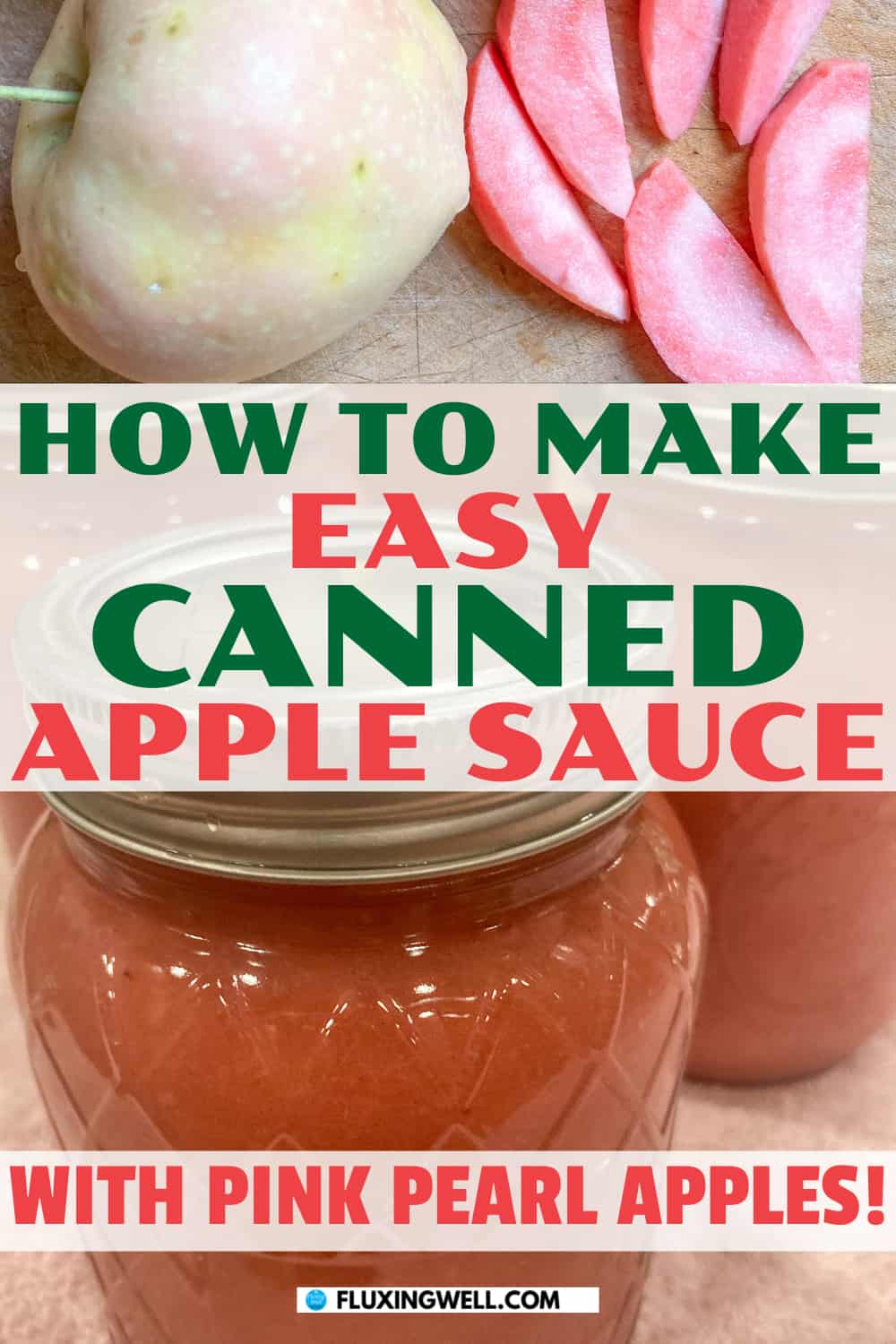





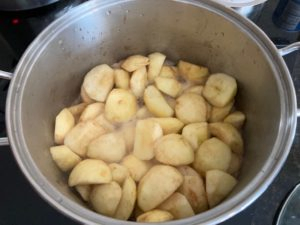
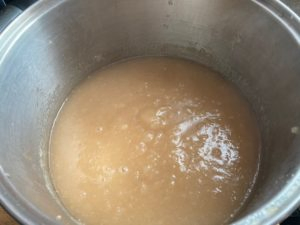


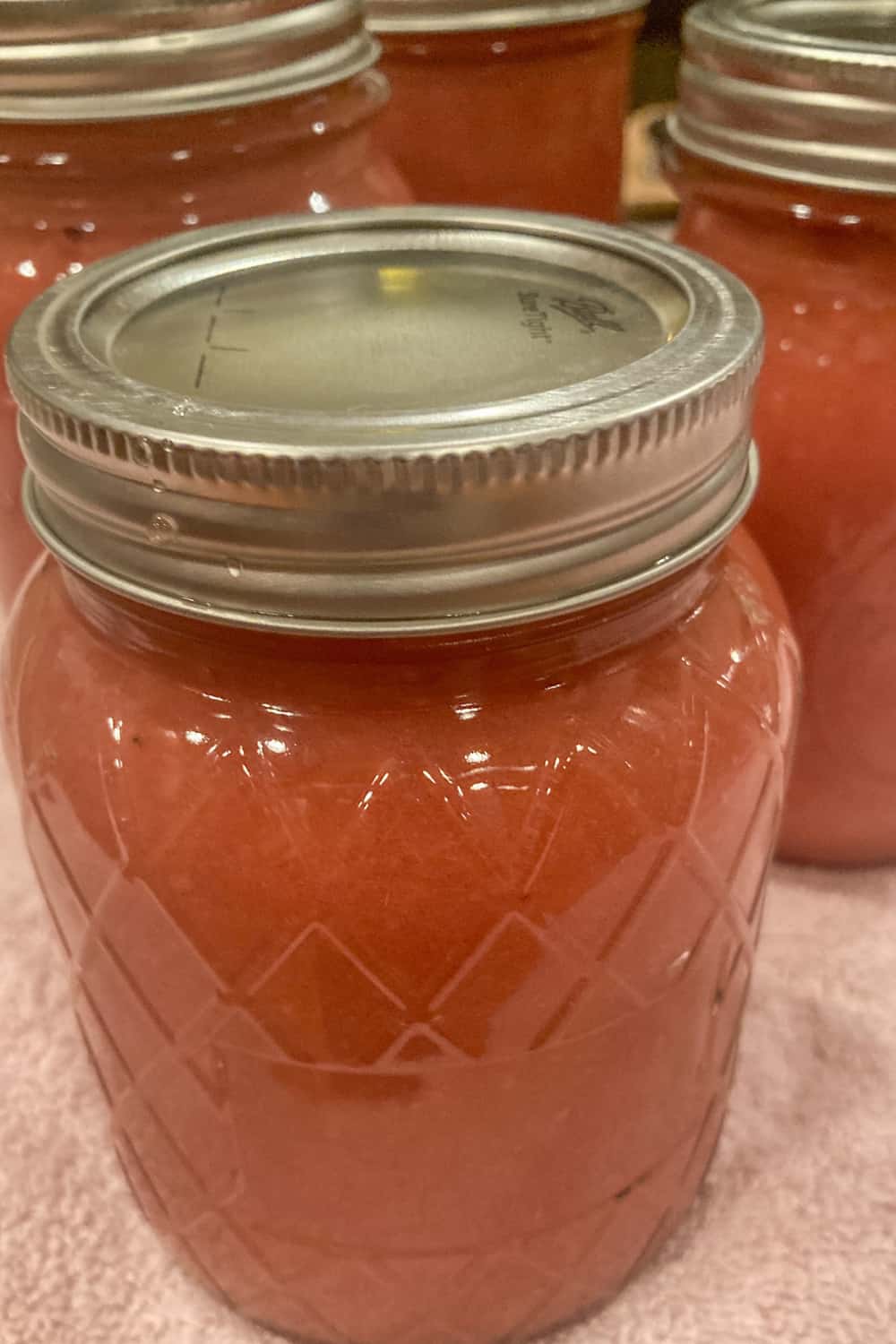

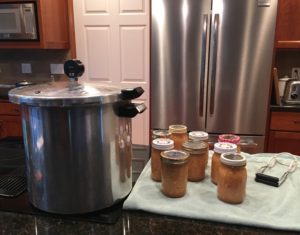


Sounds delicious! I love homemade applesauce and make it occasionally, but I have never canned it.
Thank you! I always figure that if I am going to take the time to make applesauce, I might as well make a lot of it. Canning applesauce is the perfect solution!
I love canning applesauce. It is so satisfying to see the shelf full of bottles you have filled and it is a great item to add to your meal.
I agree! Glad you are a fellow homemade canned applesauce fan.
Thanks for sharing this easy homemade canned applesauce recipe! So many helpful tips and useful information!
Thank you! I am glad you liked the tips and found them useful.
such a great post and explanations on can very helpful!
Making canned applesauce is easy!
I love applesauce, but never tried making my own homemade version. These are wonderful instructions on how to make easy canned applesauce with both pink pearl apples or our own custom apple blend. I’m inspired to give it a try this fall.
Great! I would love to know the apple blend you choose for your canned applesauce.
I used this applesauce recipe this past weekend. It turned out very well. Thanks for all of the tips you included.
You are welcome. I love it when people try the recipes I share!
ohhh, our toddler decided she loved apples last week but this week won’t touch them. So I have a whole bunch of apples- I’ll have to try this. I’ve never heard of using apple sauce as a condiment!!!
The more I use it, the more I like it, especially on pork chops and sausage.=)
A brilliant post! I’ve never made applesauce before so I’d love to give it a try! I’ll be sure to follow the recipe and I’m excited to see how it turns out! 😊
Thanks for the feedback, Anna! You made my day! Have fun trying the recipe.
Lisa
Ooo I love apple sauce, thank you for sharing your recipe!
Brooke x
You are most welcome! I hope you get a chance to try making it. Have a super day!
Lisa